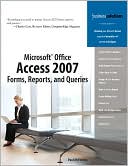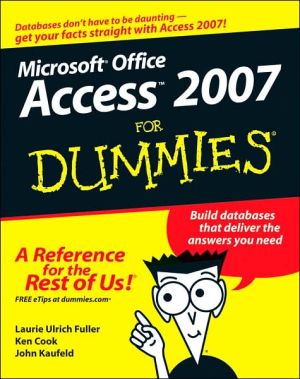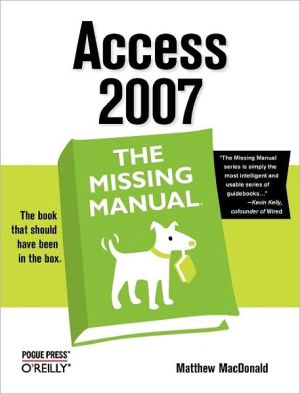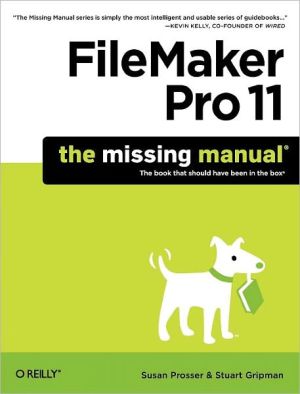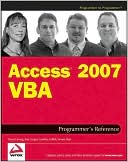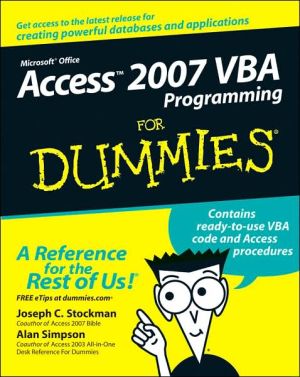Microsoft Office Access 2007 Forms, Reports, and Queries
Search in google:
“Everything you need to master Access 2007 forms, reports, and queries.”–Charles Carr, Reviews Editor, ComputorEdge MagazineCreate Forms for BusinessEnsure Data Entry AccuracyBuild Elegant Form InterfacesCollect Data Via EmailDesign Effective Business ReportsMake an Invoice ReportCreate Mailing LabelsExtract DataWork with Multiple TablesCalculate DiscountsAnalyze DataDevelop your Microsoft Access expertise instantly with proven techniquesLet’s face it: Microsoft Access is a large, intimidating program. Most people never progress beyond creating simple tables and using wizards to build basic forms and reports. At the same time, you need information and you know that what you seek is embedded somewhere in your Access database. Without a more sophisticated knowledge of how to extract and present that data, you’re forced to rely on office gurus and overworked IT people to provide canned reports or one-size-fits-all solutions.This book changes all that by giving you the skills to build efficient front-ends for data (forms), publish the results in an attractive and easy-to-read format (reports), and extract the data you need (queries). This book shuns the big Access picture and instead focuses intently on forms, reports, and queries. This in-depth approach will give you the knowledge and understanding you need to get at the data and prove the old saw that knowledge is power.· Focuses on the three technologies that you must master to get the most out of Access: forms, reports, and queries.· Avoids database theory in favor of practical know-how that you can put to use right away.· Packed full of real-world examples and techniques to help you learn and understand the importance of each section.· Covers what’s new and changed in Microsoft Access 2007.IntroductionPart I: Creating Forms Chapter 1 Creating and Using a FormChapter 2 Working with Form ControlsChapter 3 Designing Forms for Efficient and Accurate Data EntryChapter 4 Designing Forms for Business UseChapter 5 Creating Specialized FormsPart II: Designing and Customizing Reports Chapter 6 Creating and Publishing a ReportChapter 7 Designing Effective Business ReportsChapter 8 Designing Advanced ReportsChapter 9 Creating Specialized ReportsPart III: Creating Powerful Queries Chapter 10 Creating a Basic QueryChapter 11 Building Criteria ExpressionsChapter 12 Working with Multiple-Table QueriesChapter 13 Creating Advanced QueriesChapter 14 Creating PivotTable QueriesChapter 15 Querying with SQL StatementsIndex
Introduction 1What's in the Book 2This Book's Special Features 2The Examples Used in the Book 3Creating FormsCreating and Using a Form 7Building a Basic Form 9Building a Standard Form 9Building a Split Form 11Building a Multiple Items Form 11Creating Simple Forms with the Form Wizard 12Navigating a Form 14Creating a Form in Design View 15Displaying the Design View 15Changing the Record Source 15Understanding Form Controls 16Adding Fields to the Form 17Changing the Size of the Form 18Viewing the Form 18Assigning an AutoFormat in Design View 19Working with Form Properties 20Working with the Form Header and Footer 20Adding a Logo 22Adding a Title 23Formatting the Background 23Creating a Form Interactively in Layout View 25Case Study: Protecting the Form and Data from Other Users 26From Here 27Working with FormControls 29Manipulating Form Controls 29Inserting Controls on a Form 30Selecting Controls 30Formatting Controls 31Adding Conditional Formatting 31Sizing Controls 33Moving Controls 34Creating a Control Layout 36Working with Control Margins 38Grouping Controls 38Ordering Overlapped Controls 39Converting an Unbound Control to a Bound Control 39Changing a Control's Type 40Setting the Tab Order 40Adding Labels to the Form 41Inserting a Label 41Editing the Label Caption 42Using Labels to Create Keyboard Shortcuts for Controls 42Adding Text Boxes to the Form 43Inserting a Text Box 43Using Text Boxes as Calculated Controls 44Case Study: Creating a Mortgage Calculator 46From Here 48Designing Forms for Efficient and Accurate Data Entry 49Preventing Errors by Validating Data 50Helping Users with Text Prompts 50Preventing Errors with Data Validation Expressions 51Using Input Masks for Consistent and Accurate Data Entry 52Using Controls to Limit Data Entry Choices 55Working with Yes/No Fields 56Using Option Buttons to Present a Limited Number of Choices 59Case Study: Using an Option Group to Select the Shipper 61Using Lists to Present a Large Number of Choices 62Entering Data with ActiveX Controls 67Entering Numbers Using a Spin Button 68Entering Numbers Using a Scrollbar 69Entering Dates Using a Calendar 71Collecting Form Data via Email 72Sending the Access Data Collection Email Message 72Replying to an Access Data Collection Email Message 74Managing the Access Data Collection Replies 75From Here 75Designing Forms for Business Use 77Using Forms in a Business Context 77Why Collect the Data? 78What Is the Data? 78Who Are Your Users? 78Ten Design Guidelines for Business Forms 79Make Forms Fast 79Make Forms Foolproof 79Mimic Paper Forms When Practical 79Give Users What They Need and Then Stop 79Don't Neglect the Keyboard 80Watch the Field Order (and the Tab Order, Too) 80Watch Your Screen Resolution 80Make Form Text Readable 80Go Easy on the Extras 81Organize Your Form Controls 81Organizing Controls on the Form 81Making Good Use of Lines and Rectangles 82Organizing with Option Groups 83Organizing with a Tab Control 84Enhancing Form Text 86Formatting Text 87Text Formatting Tips and Guidelines 87Applying Fancier Form Formatting 88Working with Colors 88Adding Images to Your Forms 91Creating a Shadow Effect for Text 92From Here 93Creating Specialized Forms 95Creating a Multiple-Table Form 95Understanding Subforms 95Creating a Form and Subform with the Form Wizard 95Creating a Subform in the Form Design View 98Working with Form Command Buttons 99Case Study: Creating a Switchboard Form 102Creating a Form Pop-Up Box or Dialog Box 103Creating a Pop-Up Form 103Creating a Modal Form 104Using a Custom Form with a Parameter Query 105Creating the Custom Form 105Adjusting the Parameter Query 106Using the Custom Form and Parameter Query 107Creating a Startup Form 107Creating a PivotChart Form 108From Here 110Designing and Customizing ReportsCreating and Publishing a Report 113Creating a Basic Report 113Creating Simple Reports with the Report Wizard 114Creating a Report in Design View 116Displaying the Design View 116Changing the Record Source 117Understanding the Architecture of Access Reports 118Understanding Report Controls 119Adding Fields to the Report 120Adding Labels to the Report 120Adding a Logo 121Adding a Title 122Adding Page Numbers to the Report 122Adding the Date and Time to the Report 123Changing the Size of a Report Section 124Previewing the Report 124Assigning an AutoFormat in Design View 125Working with Report Properties 126Formatting the Background 126Manipulating Report Controls 128Creating a Report Interactively in Layout View 136Publishing a Report 137Publishing on Paper 137Publishing to Email 138Exporting to Word 138Exporting to PDF or XPS 139From Here 140Designing Effective Business Reports 141Using Reports in Business 141What's in the Report? 142What Is the Goal of the Report? 142Who Are Your Readers? 144Ten Design Guidelines for Business Reports 145Copy Legacy Reports When Practical 145Give Users What They Need, Then Stop: Part 1 145Give Users What They Need, Then Stop: Part 2 145Use Page Numbers 146Use Dates and Times 146Watch the Field Order 146Watch Your Screen Resolution 146Make Report Text Readable 147Always Sort and/or Group Data 147Organize the Report Layout 147Organizing Controls on the Report 147Making Good Use of Lines and Rectangles 148Creating Page Breaks 149Enhancing Report Text 150Formatting Text 150Text Formatting Tips and Guidelines 151Applying Fancier Report Formatting 152Working with Colors 152Adding Images to Your Reports 153Adding Special Effects 154Creating a Shadow Effect for Text 154From Here 155Designing Advanced Reports 157Sorting and Grouping a Report 157Setting Up Sorting Options 158Setting Up Grouping Options 158Sorting and Grouping Using an Expression 161Adding Calculations to a Report 161Using the Totals List 162Inserting a Text Box 162Using Text Boxes as Calculated Controls 163Case Study: Creating an Invoice Report 165Using Advanced Methods to Launching a Report 167Launching a Report with a Command Button 167Launching a Report with a Macro 169Controlling Report Output 174Adding Page Breaks After Sections 174Starting Sections at the Top of a Row or Column 174Avoiding Widowed Records 175From Here 175Creating Specialized Reports 177Creating a Multiple-Column Report 177Setting Up the Report 178Tweaking the Page Setup 178Troubleshooting Multiple Columns 180Case Study: Using Multiple Columns to Reduce Report Page Count 181Creating Mailing Labels 184Running the Label Wizard 185Creating a Custom Label 187Creating a Mail Merge Report 187Creating a Multiple-Table Report 189Understanding Subreports 190Creating a Report and Subreport with the Report Wizard 191Creating a Subreport in the Report Design View 192Creating a PivotChart Report 194From Here 195Creating Powerful QueriesCreating a Basic Query 199Sorting Records 199Sorting on a Single Field 200Sorting on Multiple Fields 200Filtering Table Data 201Filtering by Selection 203Filtering Excluding Selection 203Filtering in Place 204Applying Text, Numeric, and Date Filters 204Filtering by Form 206Learning About Filter Criteria 207Creating a Filter 208Working with Queries 210Creating a Query 210Creating a New Query Object 211Selecting the Fields to Include in the Query 212Entering the Query Criteria 213Excluding a Field from the Query Results 213Returning Only the Top N Values 213Setting Field Properties 214Running the Query 215Querying Notes for Business Users 216Case Study: Querying for a Mail Merge 217Querying the Customers Table 218Running the Mail Merge 219Creating Queries with the Query Wizards 220Creating Crosstab Queries 220Creating Find Duplicates Queries 222Setting Up a Find Unmatched Query 222Working with a Query Dynaset 223Understanding the Datasheet View 223Navigating Fields 224Entering Data 224Adding More Records 225Navigating Records 225Selecting a Record 226Copying a Record 226Deleting a Record 227Formatting the Datasheet 227Working with Query Properties 228From Here 229Building Criteria Expressions 231Using Operands in Criteria Expressions 232Literals 232Identifiers 232Functions 233Using Operators in Criteria Expressions 233Comparison Operators 233Arithmetic Operators 234The Like Operator 235The Between...And Operator 235The In Operator 235The Is Null Operator 235Compound Criteria and the Logical Operators 236Using the Logical Operators 237Understanding Operator Precedence 238Setting Up a Calculated Column 239Calculating Inventory Value 240Calculating Discounted Product Totals 241Using the Built-In Functions 241Using Text Functions 243Using Date and Time Functions 246Using Math Functions 251Using Financial Functions 253Working with the Expression Builder 256From Here 257Working with Multiple-Table Queries 259Relational Database Fundamentals 259The Pitfalls of a Nonrelational Design 259How a Relational Design Can Help 262Types of Relational Models 264The One-to-Many Model 264The One-to-One Model 265The Many-to-Many Model 265Enforcing Referential Integrity 266Establishing Table Relationships 267Understanding Join Lines 267Identifying Join Types 268Adding Tables to the Relationships Window 269Joining Tables 269Editing a Relationship 271Removing a Join 271Working with Multiple Tables in a Query 271Adding Multiple Tables to a Query 271Adding Fields from Multiple Tables 272Nesting Queries Within Queries 273Joining Tables Within the Query Design Window 274Creating Other Types of Joins 275Creating Outer Joins 275Creating Self-Joins 278Creating Theta Joins 279Creating a Unique Values Query 280Case Study: Drilling Down to the Order Details 282Adding a Subdatasheet to a Query 284Working with Query Subdatasheets 284From Here 286Creating Advanced Queries 287Creating a Totals Query 287Displaying the Total Row in the Design Grid 288Setting Up a Totals Query on a Single Field 289Setting Up a Totals Query on Multiple Fields 289Filtering the Records Before Calculating Totals 290Creating a Totals Query for Groups of Records 291Grouping on Multiple Fields 291Creating a Totals Query Using a Calculated Field 293Creating a Totals Query Using Aggregate Functions 294Combining Aggregate Functions and Totals 295Creating Queries That Make Decisions 296Making Decisions with the IIf Function 297Making Decisions with the Switch Function 299Case Study: Calculating a Customer Discount Rate 300Calculating a Simple Discount Rate 300Calculating a Complex Discount Rate 301Running Parameter Queries 302Creating a Simple Query Parameter 302Specifying the Parameter Data Type 304Running Action Queries 304Modifying Table Data with an Update Query 304Removing Records from a Table with a Delete Query 306Creating New Tables with Make-Table Queries 307Adding Records to a Table with an Append Query 309From Here 309Creating PivotTable Queries 311What Is a PivotTable? 311How PivotTables Work 312Some PivotTable Terms 313Creating a One-Dimensional PivotTable 314Display Data Field Details 314Displaying the Sum of the Data Field Values 316Hiding and Showing the Data Details 318Inserting an AutoCalc Data Field Summary Calculation 318Changing the AutoCalc Calculation Type 320Creating a Calculated Field 321Removing a PivotTable Field 322Creating a Multiple-Field One-Dimensional PivotTable 322Creating a Two-Dimensional PivotTable 323Analyzing Customer Orders by Product Category 324Adding a Temporal Dimension to the PivotTable 326Filtering a PivotTable 332Using the PivotTable AutoFilters 332Displaying Only the Top or Bottom Items 333Grouping Field Items 335Adding a Filter Field 335Pivoting a PivotTable 336Moving a Field to a Different Area 337Changing the Field Order 338Formatting a PivotTable 339From Here 339Querying with SQL Statements 341Viewing the SQL Statement 341Using SQL to Perform a Select Query 342Understanding the SELECT Statement 343Using SQL with Multiple-Table Queries 346Adding a Calculated Column to the SELECT Statement 349Using SQL to Total and Group Records 350Using SQL to Set Up a Parameter Query 350The Full SQL SELECT Syntax 351Using SQL to Perform Action Queries 351Using SQL to Perform an Update Query 352Using SQL to Perform a Delete Query 352Using SQL to Perform a Make-Table Query 353Using SQL to Perform an Append Query 353Using SQL to Create Subqueries 354Using a Subquery to Define a Field 355Determining Whether a Unit Price Is Greater Than the Average 355Using a Subquery to Define Criteria for a Field 356Using Subqueries That Return Dynasets 356In Predicate: Customers Who Have Placed Orders 357All Predicate: Products Cheaper Than All the Condiments 358Using SQL to Create Union Queries 359From Here 360Index 361
